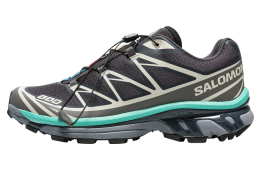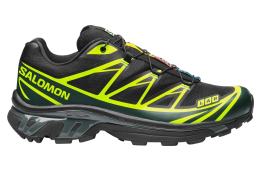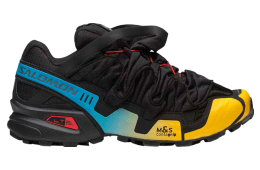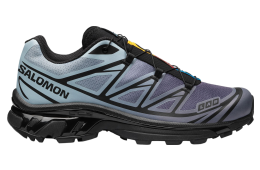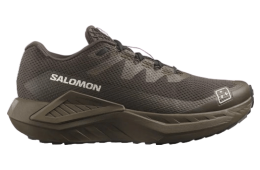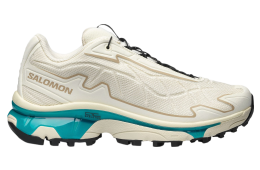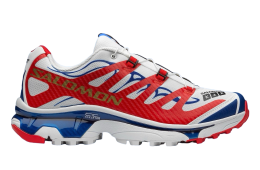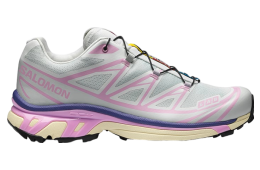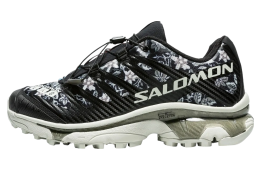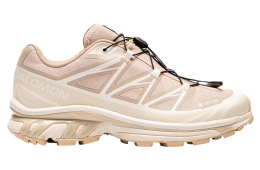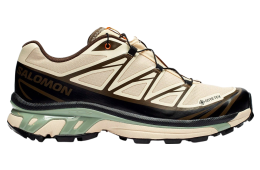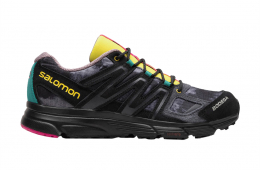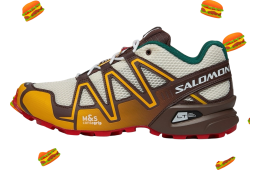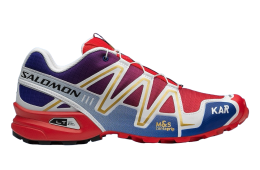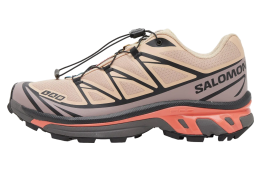Salomon
Salomon, a brand synonymous with outdoor adventure and rugged terrains, has carved a niche for itself with its innovative and high-performance sneakers. Originally founded in the heart of the French Alps in 1947, Salomon initially specialized in ski equipment before transitioning into outdoor gear, including footwear. Their sneakers are particularly renowned for their durability, excellent traction, and comfort, making them a favorite among trail runners, hikers, and outdoor enthusiasts. One standout feature is their use of advanced materials and technologies such as the Contagrip outsole, which provides exceptional grip on varied surfaces, and the Sensifit system, which ensures a secure and snug fit.
In recent years, Salomon has expanded its reach beyond just the outdoor community and into the realms of fashion and streetwear, driven by collaborations with designers and influencers. This crossover appeal has seen Salomon sneakers being worn not just on rugged trails but also in urban settings, blending functionality with a sleek, modern aesthetic. Models like the Salomon Speedcross and the S/LAB series have become celebrated for both their technical prowess and stylish designs. This dual appeal has propelled the brand into a wider market, maintaining its core values of performance and innovation while adapting to contemporary fashion trends.
read moreHistory of Salomon
The History of Salomon: From Timber Saws to Trailblazers
Introduction
Salomon is a name that resonates globally with outdoor enthusiasts, particularly those with a passion for skiing, hiking, and trail running. What began as a modest workshop in the French Alps has evolved into an iconic brand synonymous with innovation, performance, and quality in the outdoor sports industry.
Founding and Early Years
Salomon's story begins in 1947 in Annecy, France, a picturesque town nestled in the French Alps. François Salomon, along with his wife Jeanne and son Georges, founded the company initially as a small workshop specializing in saw blade production. François, a skilled metalworker, saw an opportunity to leverage his expertise in metal processing to design innovative solutions for the burgeoning ski market. Recognizing the potential for innovation, Georges began to steer the company’s focus towards the niche of ski edge production.
By the 1950s, Salomon had established itself as a key supplier of metal ski edges, a significant leap from their origins in saw blades. The transition marked the beginning of the brand's long-standing association with the ski industry.
Innovation in Ski Bindings
The 1950s and 60s marked a period of rapid innovation for Salomon, particularly in the realm of ski bindings. Georges Salomon was driven by a visionary zeal to improve the safety and performance of skiing equipment. In 1957, Salomon introduced the first cable binding, which allowed for better control and safety compared to the existing leather straps used by skiers. This innovation laid the groundwork for what was to come.
The true breakthrough, however, came in 1972 with the launch of the Salomon S505 binding. This product featured a revolutionary step-in design and a self-release mechanism, which significantly enhanced skier safety by reducing the risk of injury during a fall. The S505 quickly became the standard in the industry and established Salomon as an innovative leader in ski equipment.
Expansion into Alpine and Nordic Skiing
As Salomon continued to innovate in the field of bindings, the company saw opportunities to expand its product range. In the 1970s, it ventured into the production of alpine and Nordic ski boots, leveraging its deep understanding of skier needs and cutting-edge technology. By 1979, Salomon had emerged as the world’s leading manufacturer of ski bindings, marking a significant milestone in the company’s history.
Ski Boots and Further Technological Advances
The 1980s were marked by further innovation and expansion. Salomon introduced the SX90 ski boot in 1980, featuring a rear-entry design that made it easier for skiers to put on and remove their boots while still offering excellent performance. This design became highly popular and added another feather to Salomon's cap.
Pushing the boundaries of technological advancement, Salomon also started investing in research and development for Nordic skiing. The company's dedication to innovation helped elevate the performance of Nordic skiing equipment, further entrenching Salomon's leadership position in the winter sports market.
Expansion beyond Winter Sports: The Athletic Footwear Revolution
The 1990s marked a pivotal decade for Salomon as the brand diversified beyond winter sports and entered the athletic footwear market. This strategic move was aimed at capturing a share in the rapidly growing outdoor and adventure sports market. The Salomon Raid Race trail running shoe, introduced in 1992, heralded the company’s foray into a completely new segment of the market.
The Raid Race was designed to offer exceptional grip, durability, and comfort. These attributes made it an instant hit among trail runners and hikers. It was the beginning of a new era, as Salomon's expertise in high-performance gear translated seamlessly from the slopes to the trails.
Adoption by Global Sports Groups
The 1990s also saw significant corporate changes for Salomon. In 1997, the company was acquired by German sportswear giant Adidas for a reported $1 billion. The acquisition spurred further growth and R&D investments, allowing Salomon to enhance its product offerings and extend its reach into global markets. Although the merger initially seemed promising, cultural and operational differences between the two companies led to challenges in fully realizing the potential synergies.
Return to Independence and Acquisition by Amer Sports
The early 2000s were a period of transition and reevaluation for Salomon. In 2005, the company was sold by Adidas to Amer Sports, a Finnish sporting goods corporation, for approximately €485 million. Under Amer Sports, Salomon regained a degree of operational independence and began to refocus on its core competencies in outdoor and winter sports.
Trail Running Dominance and the Rise of the S/LAB Series
As the new millennium progressed, trail running exponentially grew in popularity, and Salomon was perfectly positioned to capitalize on this trend. The launch of the S/LAB series in the 2010s represented another major leap in innovation. This premium line of products was designed in collaboration with elite athletes, incorporating cutting-edge technology and materials to deliver unparalleled performance.
The S/LAB footwear, in particular, gained a near-cult following among ultra-runners and trail enthusiasts, reinforcing Salomon's reputation as the brand of choice for serious athletes. Additionally, the brand introduced the Advanced Skin hydration packs and other trail-specific gear, making it a one-stop shop for all trail running needs.
Expansion into Lifestyle and Fashion
Recognizing the changing dynamics of the consumer market, Salomon strategically expanded its footprint into the lifestyle and fashion segments. The brand’s outdoor performance gear began to be embraced by urban consumers for both functional and aesthetic reasons. Collaborations with well-known designers and limited-edition releases injected a fresh, modern vibe into the brand's portfolio, broadening its appeal beyond hardcore athletes to fashion-forward urbanites.
Technological Innovations and Sustainable Practices
With the growing emphasis on sustainability and environmental responsibility, Salomon undertook significant measures to minimize its ecological footprint. The company invested in sustainable materials, eco-friendly manufacturing processes, and recycling programs. Initiatives like the Play Minded Program underscored Salomon’s commitment to environmental stewardship and corporate responsibility.
Technological advancements continued to be a hallmark of Salomon's growth. From their patented Contagrip outsoles offering superior traction to innovative Quicklace systems providing easy adjustments, Salomon consistently set new benchmarks in outdoor performance gear.
The Present and Future
As of the 2020s, Salomon remains an influential player in the outdoor sports market. The brand continues to innovate across various product categories, including skiing, trail running, hiking, and lifestyle gear. Moreover, Salomon maintains a strong commitment to supporting the outdoor community through sponsorships, events, and collaborations.
The acquisition of Amer Sports by a consortium led by Anta Sports in 2019, a move valued at around €4.6 billion, opened new avenues for Salomon’s growth, particularly in the Asian markets.
Conclusion
From its humble beginnings in a small French workshop to its current status as a global leader in outdoor sports equipment, Salomon's journey is a testament to relentless innovation and adaptability. The brand has continually evolved to meet the needs of athletes and outdoor enthusiasts, always staying true to its ethos of performance and quality. Whether on snow-covered slopes, rugged trails, or urban environments, Salomon's legacy endures, inspiring future generations to explore and conquer the great outdoors.
In essence, the history of Salomon is not just a chronicle of products and innovations; it is a story of passion, vision, and an unwavering commitment to enhancing the human experience in the great outdoors.

